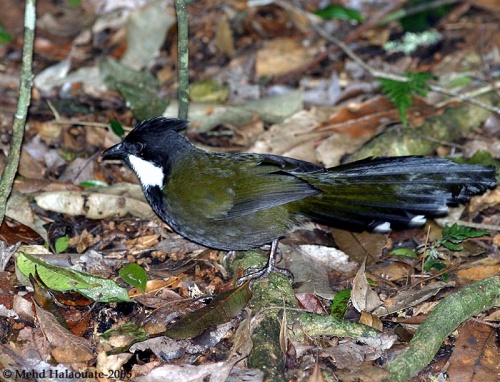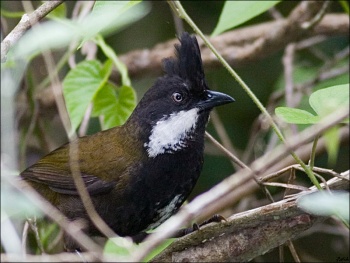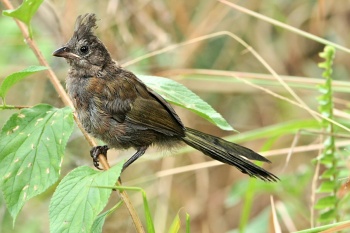(Photo captions. References updated) |
(Picture of Juvenile. References updated) |
||
| Line 13: | Line 13: | ||
* ''Lateralis'' with brighter upperparts and shorter wings and tail | * ''Lateralis'' with brighter upperparts and shorter wings and tail | ||
Sexes similar. Juveniles are duller, have a smaller crest and no white cheek patch | Sexes similar. Juveniles are duller, have a smaller crest and no white cheek patch | ||
| − | [[Image:EasternWhipbird02.jpg|thumb| | + | [[Image:EasternWhipbird02.jpg|thumb|350px|right|Photo by {{user|fthsm|fthsm}}<br />Sydney, [[Australia]]]] |
==Distribution== | ==Distribution== | ||
Eastern [[Australia]] from northern [[Queensland]] south to [[Victoria]].<br /> | Eastern [[Australia]] from northern [[Queensland]] south to [[Victoria]].<br /> | ||
Common in its range. | Common in its range. | ||
==Taxonomy== | ==Taxonomy== | ||
| − | There are 2 subspecies: | + | ====Subspecies==== |
| + | There are 2 subspecies<sup>[[#References|[1]]]</sup>: | ||
* ''P. o. lateralis'' in northeast [[Queensland]] and northeast [[Australia]] | * ''P. o. lateralis'' in northeast [[Queensland]] and northeast [[Australia]] | ||
* ''P. o. olivaceus'' from east-central [[Queensland]] south to southeast [[Victoria]] | * ''P. o. olivaceus'' from east-central [[Queensland]] south to southeast [[Victoria]] | ||
Proposed ''magnirostris'' usually merged with nominate. | Proposed ''magnirostris'' usually merged with nominate. | ||
==Habitat== | ==Habitat== | ||
| + | [[Image:EasternWhipbird Imm 2458s.jpg|thumb|350px|right|Juvenile<br />Photo by {{user|kerriebr|kerriebr}}<br />Tallai, Gold Coast, [[Queensland]], November 2012]] | ||
Dense vegetation, wet habitats, rainforest, eucalypt forest and dense scrub near watercourses. Occurs from sea-level to 1500m. | Dense vegetation, wet habitats, rainforest, eucalypt forest and dense scrub near watercourses. Occurs from sea-level to 1500m. | ||
==Behaviour== | ==Behaviour== | ||
| Line 35: | Line 37: | ||
A long whip call; male - drawn out ''whip crack'', female follows with sharp ''choo choo.'' | A long whip call; male - drawn out ''whip crack'', female follows with sharp ''choo choo.'' | ||
==References== | ==References== | ||
| − | #{{Ref- | + | #{{Ref-Clements6thOct12}}#{{Ref-HBWVol12}}#{{Ref-Simpson98}} |
{{ref}} | {{ref}} | ||
==External Links== | ==External Links== | ||
Revision as of 22:08, 9 November 2012
Alternative names: Whipbird; Coachwhip Bird; Stockwhip Bird
- Psophodes olivaceus
Identification
26-30cm.
- Dark olive green upperparts
- Grey white below
- Black head and breast
- Broad white patch on side of face
- Black crest
- Cream iris
- Black bill
- Lateralis with brighter upperparts and shorter wings and tail
Sexes similar. Juveniles are duller, have a smaller crest and no white cheek patch
Distribution
Eastern Australia from northern Queensland south to Victoria.
Common in its range.
Taxonomy
Subspecies
There are 2 subspecies[1]:
- P. o. lateralis in northeast Queensland and northeast Australia
- P. o. olivaceus from east-central Queensland south to southeast Victoria
Proposed magnirostris usually merged with nominate.
Habitat
Dense vegetation, wet habitats, rainforest, eucalypt forest and dense scrub near watercourses. Occurs from sea-level to 1500m.
Behaviour
Shy and hard to see. Forages on the ground singly or in loose groups. Attends foraging Australian Logrunner.
Diet
The diet includes insects and small invertebrates.
Breeding
The female builds a cup shaped nest from sticks and bark, lined with fine grasses. 2-3 eggs are laid and are incubated by the female for 18 days. Both parents care for the young which fledge about 12 days later. Sometimes there are two broods.
Resident species.
Vocalisation
A long whip call; male - drawn out whip crack, female follows with sharp choo choo.
References
- Clements, J. F., T. S. Schulenberg, M. J. Iliff, B.L. Sullivan, C. L. Wood, and D. Roberson. 2012. The eBird/Clements Checklist of Birds of the World. 6th ed., with updates to October 2012. Ithaca: Cornell Univ. Press. ISBN 978-0801445019. Spreadsheet available at http://www.birds.cornell.edu/clementschecklist/downloadable-clements-checklist
- Del Hoyo, J, A Elliott, and D Christie, eds. 2007. Handbook of the Birds of the World. Volume 12: Picathartes to Tits and Chickadees. Barcelona: Lynx Edicions. ISBN 978-8496553422
- Simpson, K and N Day. 1998. Field Guide to the Birds of Australia. London: Christopher Helm. ISBN 0-7136-4877-5
Recommended Citation
- BirdForum Opus contributors. (2024) Eastern Whipbird. In: BirdForum, the forum for wild birds and birding. Retrieved 11 May 2024 from https://www.birdforum.net/opus/Eastern_Whipbird






